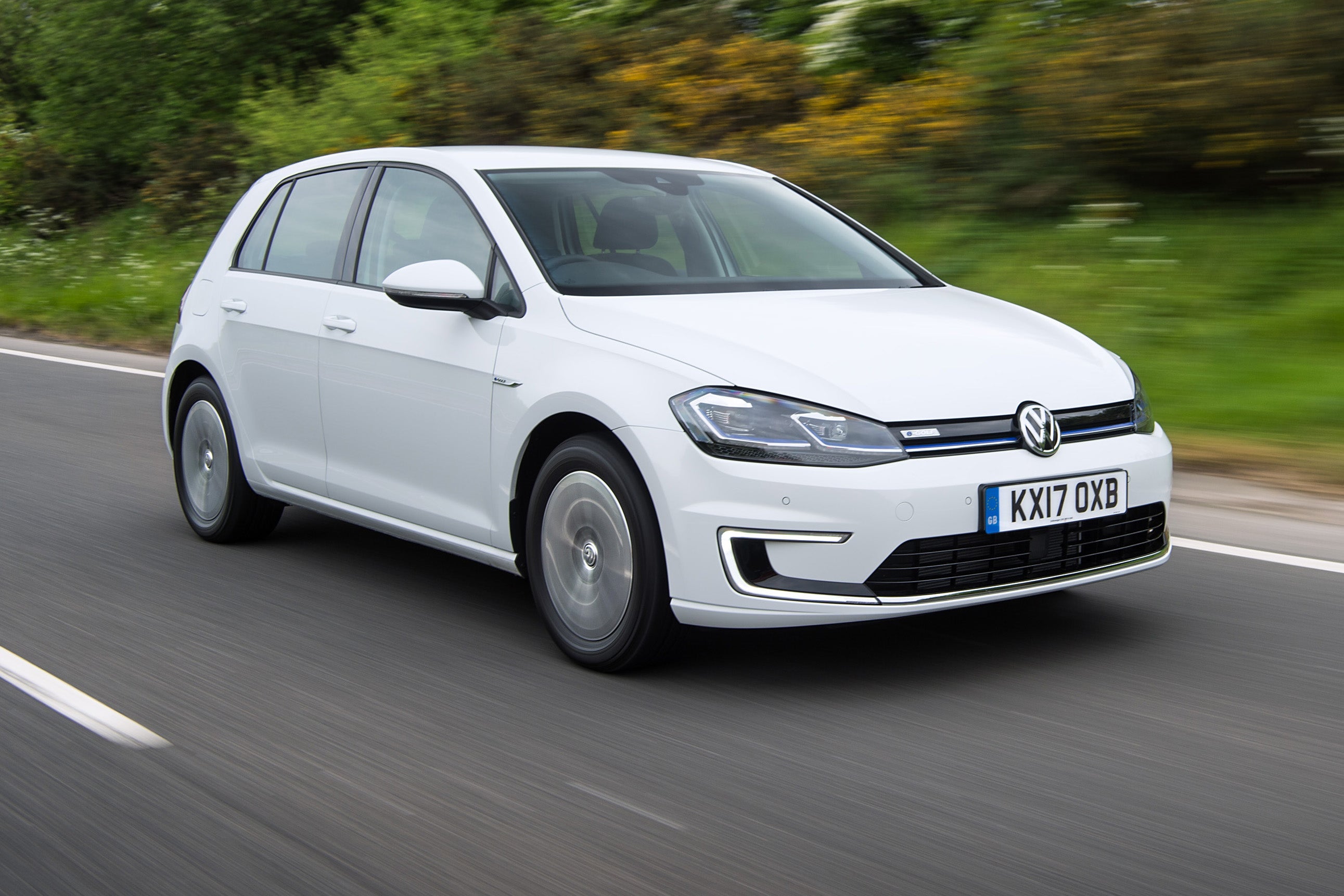Volkswagen e-Golf (2014-2020) Review
Written by Andrew Brady
Quick overview
Pros
- Feels like a conventional Golf
- Fun to drive yet also very refined
- Less ubiquitous than the Nissan Leaf
Cons
- Won’t travel far enough between charges for some drivers
- Surprisingly expensive on the used market
- Ride quality isn’t as good as a standard Golf
Overall verdict on the Volkswagen e-Golf
"The Volkswagen e-Golf is the ideal introduction to electric cars. It feels just like a more refined version of the (already ultra-refined) Volkswagen Golf. It doesn’t shout about its electric credentials, but it’s superb to drive and comes well kitted out for the money. The biggest drawback is that it’s so good, it’s holding its value surprisingly well."

Some electric cars make a big thing out of being different. If you buy a BMW i3 or a Tesla Model 3, you’re making a statement - showing off your eco credentials for all the world to see. You could even say the same about the Volkswagen ID.3, the indirect replacement for the e-Golf featured here. That suits some buyers, but others just want a good car that happens to have an electric motor instead of a petrol or diesel engine. That's where the Volkswagen e-Golf steps in.
As you'll read in our full Volkswagen e-Golf review, VW's electric car takes an already excellent family hatchback in the shape of the Volkswagen Golf and slots in an electric motor to provide smooth acceleration and levels of refinement akin to a much more expensive, premium vehicle. It’s great fun to drive, with instant acceleration and agile handling. It’s a relaxing companion around town, too, but also feels equally comfortable out on the open road (provided you don’t mind stopping for regular charges).
The e-Golf went on sale in 2014 and this means there’s plenty of choice on the used market, although it’s never sold in as big numbers as the Nissan Leaf. As such, values are quite strong (they are for the standard Golf, too), but you get what you pay for: a classy interior, lots of standard equipment and a big-car driving experience.
The e-Golf’s cabin is both spacious and upmarket, with lots of quality materials used and a stylish design. The boot is a little smaller than a standard Golf, meaning you might want to consider something bigger like the MG ZS EV if you’re looking to use it as your main family car.
Look for a post-2017 model for a more powerful motor along with a bigger battery. This gives the e-Golf a realistic range of around 120 miles between charges in the real world. That might sound pretty crummy if you’re used to a petrol or diesel, but as a second car used for short, local journeys, it’ll be enough for many buyers. You’ll soon get into the habit of charging it up overnight and never have to visit a petrol station again. Other upgrades in late-2017 include a bigger navigation system and a fancy 12.3-inch digital display dials display offered as an option.
Family buyers will be pleased to discover that the e-Golf’s a safe choice, with a host of standard safety technology including autonomous emergency braking and Isofix points for fitting child seats. When the standard Golf was tested by Euro NCAP in 2014, it was awarded an impressive five-star rating.
It also makes a lot of sense as a used purchase. As an electric car, there are fewer moving parts to go wrong than in a petrol or diesel model, so should prove to be reliable and cheap to run. Volkswagen also provides an eight-year/100,000-mile battery warranty which should put your mind at ease.
Looking for a used car for sale? We've got 100s of Volkswagen Approved Used Cars for Sale for you to choose from, including a wide range of VW e-Golf models for sale.
Is the Volkswagen e-Golf right for you?
If you want a classy electric car that doesn’t feel too obscure, the e-Golf is an excellent choice. It has a brilliant, upmarket interior which is ageing well, and updates in 2017 brought more up-to-date technology. It’s arguably even better to drive than a standard Golf, with quick responses and sharp (if not exciting) handling. The ride quality’s a little harsh on rough roads but it’s still more comfortable than a lot of electric cars.
The electric range looks a little limited compared to newer alternatives, but that’s reflected in the price. It’ll be sufficient for the majority of buyers, particularly if most of your journeys are around town or you’re considering an e-Golf as a second car.
What’s the best Volkswagen e-Golf model to choose?
There isn’t an extensive e-Golf line-up but that makes searching for a used example easier. You might wish to shortlist your favourite colours and there are certain desirable options which are worth looking out for (the heat pump, for example) - but no e-Golf choice is a bad one.
If your budget allows, we’d look for one of the later models, introduced in September 2017 and identified by the bigger infotainment screen. These have a bigger battery and more powerful electric motor, providing more exhilarating performance (that might be pushing it…) and a slightly longer electric range.
What other cars are similar to the Volkswagen e-Golf?
The obvious rival is the ever-popular Nissan Leaf - arguably the first mainstream electric car and one that continues to be a popular choice today. Its popularity means there are more on the used market than the e-Golf, but it’s not as good to drive as the Volkswagen and the interior is disappointing.
We’d also recommend the Hyundai Ioniq Electric, which is one of our favourite EVs. It comes with a generous five-year/unlimited mileage warranty, too. If you need practicality, you should also consider the Kia e-Niro or the MG ZS EV.
Comfort and design: Volkswagen e-Golf interior
"The interior of electric cars varies dramatically. In some (we’re looking at you, Nissan Leaf…), you get the sense that the budget has been spent on technology, leaving little for the interior. In others (Honda E, BMW i3), the interior has been completely reimagined into nothing like you’ve ever seen in a car before."
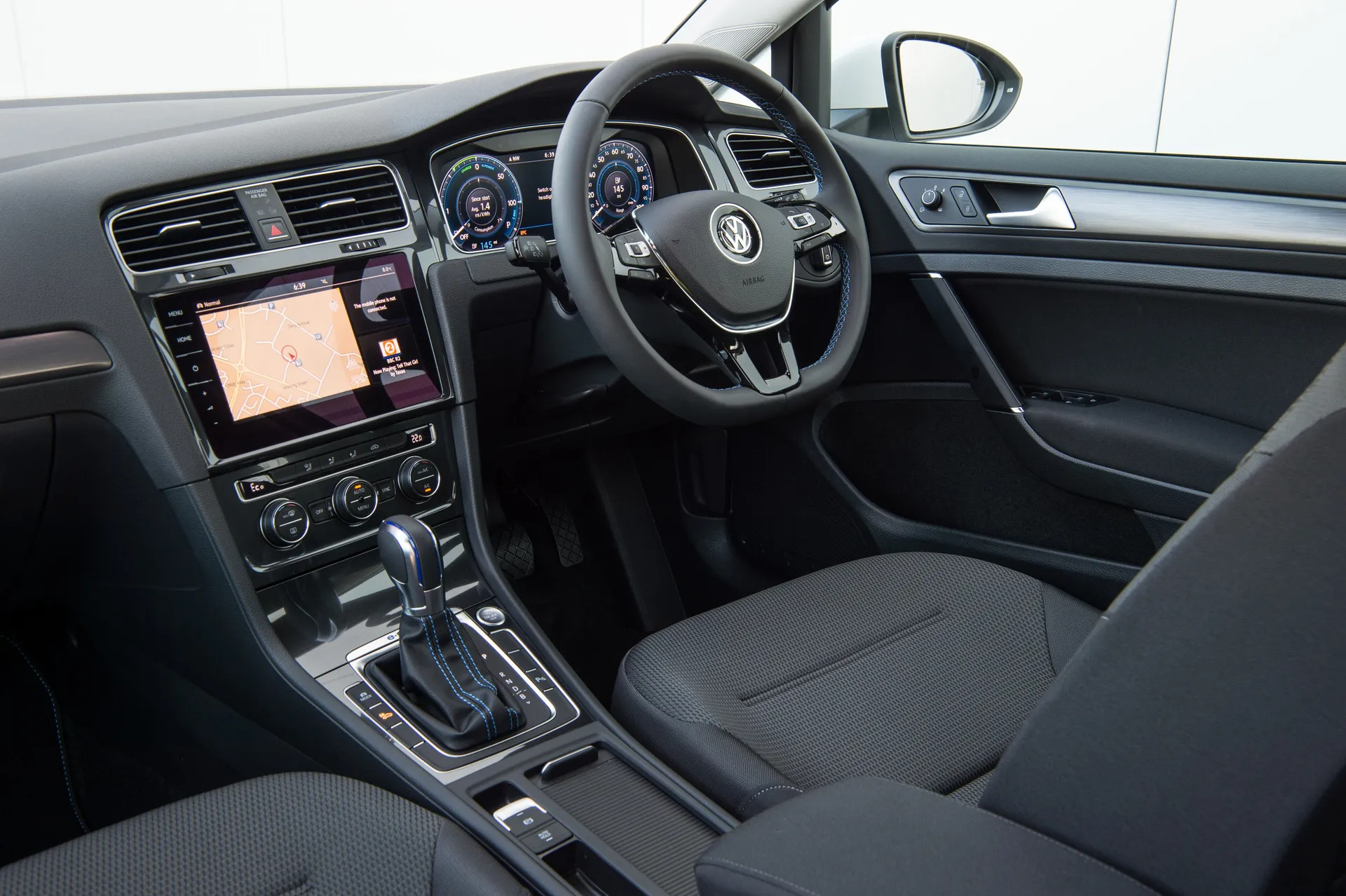
The Volkswagen e-Golf sits somewhere in the middle. It feels, well, just like a Golf. That’s a good thing in our opinion as the standard Golf has a superb, well-designed interior that feels a cut above alternatives like the Ford Focus. If you’re expecting something a little wacky that reminds your passengers at every opportunity that you’ve bought an electric car, you might find the e-Golf a little lacking.
Look closely and you’ll find a few telltale signs that you’re in an e-Golf. There’s some blue stitching on the leather steering wheel along with an e-Golf logo. There’s another logo on the gear knob. And, er, that’s about it. Still, the e-Golf’s cabin is every bit as comfortable and well designed as the standard car. It feels very grown-up, with smart-looking switches laid out exactly where you’d want them.
There’s plenty of adjustment in the seats and steering wheel, meaning you should find a comfortable driving position without much difficulty. We found that the seats are a little on the firm side, but they’re also quite flat - meaning you’ll move about quite a bit during fast cornering. Adjustable lumbar support is fitted as standard, which is a bonus.
Quality and finish
In typical Volkswagen style, the e-Golf’s interior feels just as high quality as much more expensive, premium cars. From the sounds of the suppressed thud as you close the door to the supple feel of the leather-covered steering wheel, it just feels like a premium product.
Everything you touch feels upmarket - even all the switchgear operates with a satisfying solidarity. It’s a car that feels like it’ll wear very well. If you’d like a bit more luxury, we’d recommend looking for an e-Golf with the desirable leather upholstery. This was quite an expensive option when it was new (costing more than £2000) so finding one might be difficult, but it does make the cabin feel that bit more special. It’s also easier to clean than the standard cloth upholstery, so might appeal to family buyers.
Infotainment: Touchscreen, USB, nav and stereo in the Volkswagen e-Golf
When it was first on sale in 2014, the e-Golf used an eight-inch Discover Pro navigation system. This was an easy system to use with slick graphics and fast responses. It still looks modern today, while its physical shortcut buttons and an actual volume knob are a refreshing change from more modern systems which rely heavily on the touchscreen.
The infotainment in the e-Golf was updated in 2017, with the screen replaced with a 9.2-inch display. The physical buttons were lost, which is a shame, but it remains easy to operate with clear graphics and logical menu layouts. This system also has Apple CarPlay and Android Auto, giving you access to apps from your phone on the move.
At the same time, a 12.3-inch digital TFT dash display was also offered as a £495 option. This is an extra that’s worth looking out for - it makes the e-Golf feel like a more contemporary electric car.
Other cool techy features of the e-Golf include Volkswagen’s Car-Net smartphone app. This is simple to use, allowing you to turn the air conditioning on remotely - ideal for cooling the car (or warming it up) while it’s on charge, saving energy on the move. It can also be used to set a start or stop time for charging (great for utilising off-peak electricity tariffs) and show you the car’s last parking location.
Space and practicality: Volkswagen e-Golf boot space
Compared to electric city cars which are little more than personal transport, the Volkswagen e-Golf is big enough for family life. There’s plenty of space up front, with decent head and legroom as well as some useful storage areas. There’s a large glovebox, a handy storage area under the centre armrest and door pockets big enough to carry two-litre water bottles.
As the e-Golf was only sold as a five-door, access to the rear is good, and there’s more space in the back than you'll find in the Nissan Leaf. Things are a little tight, though, especially if you need to carry three adults. A central transmission tunnel creates a lump in the floor, limiting foot room for middle-seat passengers, but kids should be perfectly happy. There are Isofix points on the outer rear seats, meaning you can easily fit two child seats in the back.
The boot is a little smaller than the standard Golf - capable of lugging 341-litres of luggage compared to 380. That’s because of the position of the batteries under the boot, which also take away space for an optional space-saver spare wheel. It’s still bigger than a lot of electric cars but, if outright practicality’s important, you might be better looking for a Kia e-Niro or MG ZS EV. The rear seats are easily dropped, if required, to provide up to 1231 litres of luggage space.
It’s worth noting that the Volkswagen e-Golf isn’t rated for towing. If you need to tow a small trailer or a caravan, you’d be better with a petrol, diesel or hybrid model.
If space on your driveway is at a premium, the e-Golf's dimensions are much the same as the standard car. It measures 4270mm in length, 1799mm in width and 1450mm in height.
Handling and ride quality: What is the Volkswagen e-Golf like to drive?
"Aside from the extra refinement of the electric motor, the e-Golf doesn’t feel spectacularly different from the standard Golf in the way it drives."
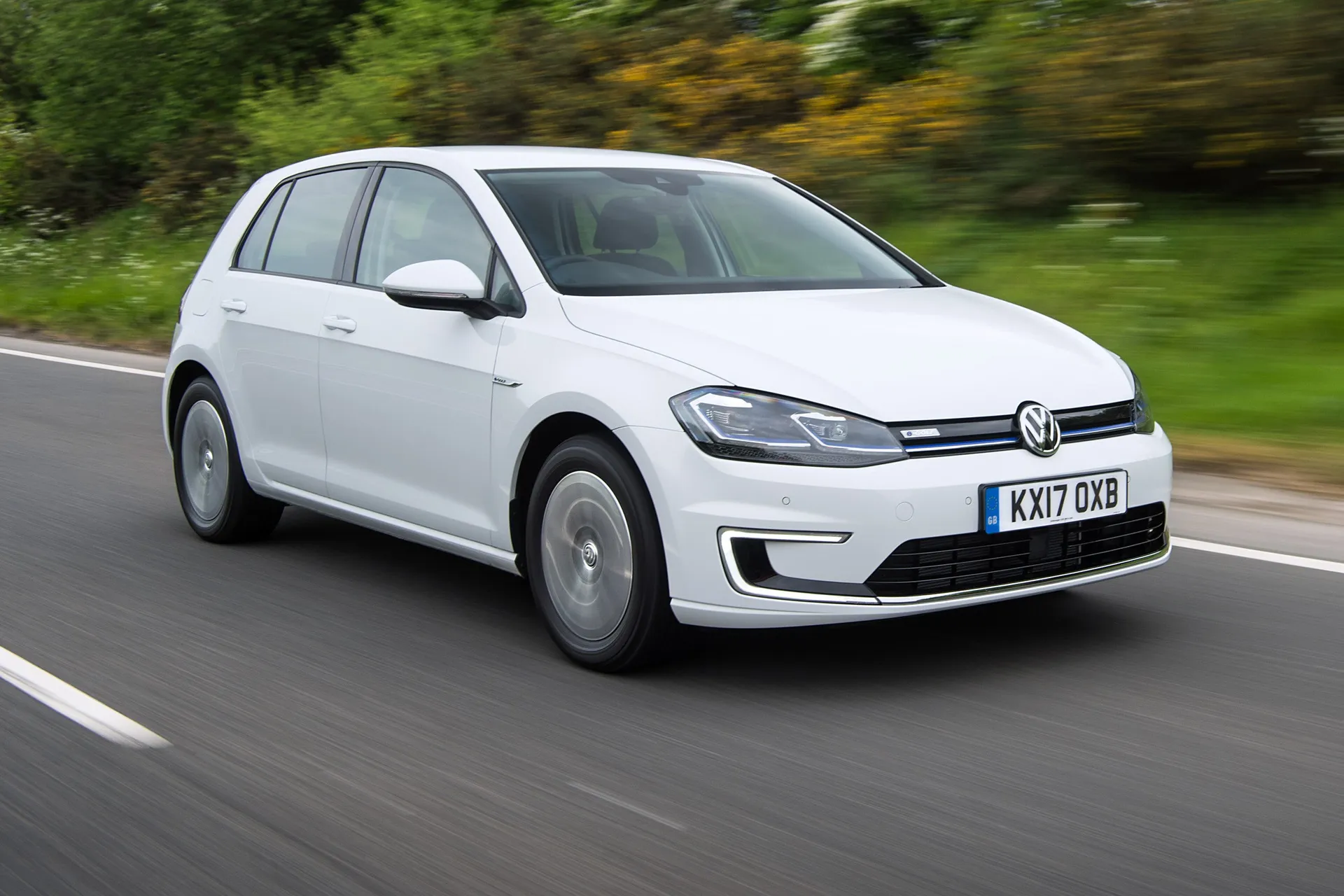
The e-Golf isn't really a car for enthusiastic driving, but it remains composed during cornering and you can predict exactly how it’s going to react to steering inputs. There’s a little bit of lean in tight bends (more so than the standard car, less than the soggy Nissan Leaf). The steering is quite light, which isn’t conducive to sporty cornering, but it’s perfect for pottering around town.
Unlike some electric cars, which feel a bit out of their depth as soon as you leave the city centre, the e-Golf is perfectly pleasant on open roads and can even tank along the motorway without any great issue. Be warned, though, the battery range starts to drop quite dramatically once you exceed 60mph.
To cope with the weight of the batteries, Volkswagen’s beefed up the e-Golf’s suspension. That means you’ll feel more lumps and bumps in the road, even with the relatively small 16-inch wheels which are fitted as standard. It shouldn’t be a deal-breaker but, like a lot of electric cars, the e-Golf is a little harsh over broken roads.
What engines and gearboxes are available in the Volkswagen e-Golf?
The original e-Golf was sold with an electric motor that produced 115PS and was combined with a single-speed gearbox and a 24.2kWh battery. A healthy 270Nm of torque available as soon as you set off and this means you can cover 0-62mph in 10.4 seconds, while top speed is limited to 87mph.
Newer versions of the e-Golf feature a bigger 35.8kWh battery and more powerful 136PS electric motor. This powertrain was added in September 2017 and Volkswagen e-Golfs with this setup can reach 62mph in 9.6 seconds, while top speed is quoted as 93mph.
Like most electric cars, the e-Golf feels quicker than the official figures suggest, especially around town. As soon as you hit the accelerator, it’ll surge forward thanks to its instant torque from the electric motor. You don’t need to wait for the revs to build or for the automatic gearbox to find the right gear -simply push the throttle and away you go. This is also useful for overtaking, although the e-Golf does start to run out of puff at higher speeds. It’ll happily pull to 50 or 60mph but, above this, you’ll have to plan your manoeuvres a bit more.
Refinement and noise levels
The standard Volkswagen Golf is one of the most refined hatchbacks on the market. Swap the grumbly petrol or diesel engine with a near-silent electric motor and you have one of the most refined cars on sale, full stop.
Listen carefully and you might hear the giveaway whir of an electric motor at low speed, but this is soon drowned out by road and wind noise. Both are a little more noticeable at high speed than they would be in a petrol or diesel car, but it’s difficult to feel anything other than relaxed when driving the e-Golf (that’s until the range starts running low, anyway).
There are three different drive modes to choose from: Normal, Eco and Eco+. If you’re not too worried about running out of electricity, we’d suggest leaving it in n=Normal for the best acceleration. Eco mode limits the top speed to 72mph, while also reducing the throttle response and even dropping the output of the air conditioning. Eco+ is best used when you’re starting to get a little desperate: with a 56mph top speed and next-to-no power from the air conditioning.
You can increase or decrease the amount of regenerative braking. We like it in its most severe level-four setting, especially around town. This uses the electric motor to slow the car down as soon as you lift off the accelerator, capturing energy and pumping it back into the battery.
It’s not quite as aggressive as the Nissan Leaf’s e-pedal and it takes a bit of getting used to, but once you get the hang of it it’s a very cool feature. With some careful driving, you’ll rarely have to use the brakes, providing relaxed one-pedal driving.
Safety equipment: How safe is the Volkswagen e-Golf?
The standard Volkswagen Golf has a reputation for being a very safe and dependable car, and we have no reason to suspect the e-Golf is any different.
When it was crash tested by Euro NCAP in 2012, the Golf was awarded a maximum five-star safety rating. That includes a commendable 94 per cent score for adult occupants and 89 per cent for children.
Standard safety equipment includes Isofix child seat anchor points for the outer rear seats, plenty of airbags (and a deactivation switch for the passenger seat), and a pre-crash preventive occupant protection system which can tighten the seat belts and close the windows if it detects a severe manoeuvre from the driver.
Adaptive cruise control is also standard, controlling the speed and slowing down/speeding up with the traffic ahead. The radars and sensors for this also enable a load of other features, including a front assist system which can warn you if you get to close to the car in front (and even apply the brakes if required).
Maximum EV range in the Volkswagen e-Golf
Under WLTP tests, the latest e-Golf (updated in September 2017) can travel up to 144 miles between charges. Around 120-130 miles is more realistic in the real-world. That’ll drop further in winter, and as the car gets older and the battery loses efficiency (incidentally, Volkswagen provides an eight-year/100,000 mile battery warranty). Earlier models had an official range of 118 miles.
Charging times: How much does it cost to charge the Volkswagen e-Golf?
"Depending on your home electricity tariff, it’ll cost you around £5 to completely charge your e-Golf."
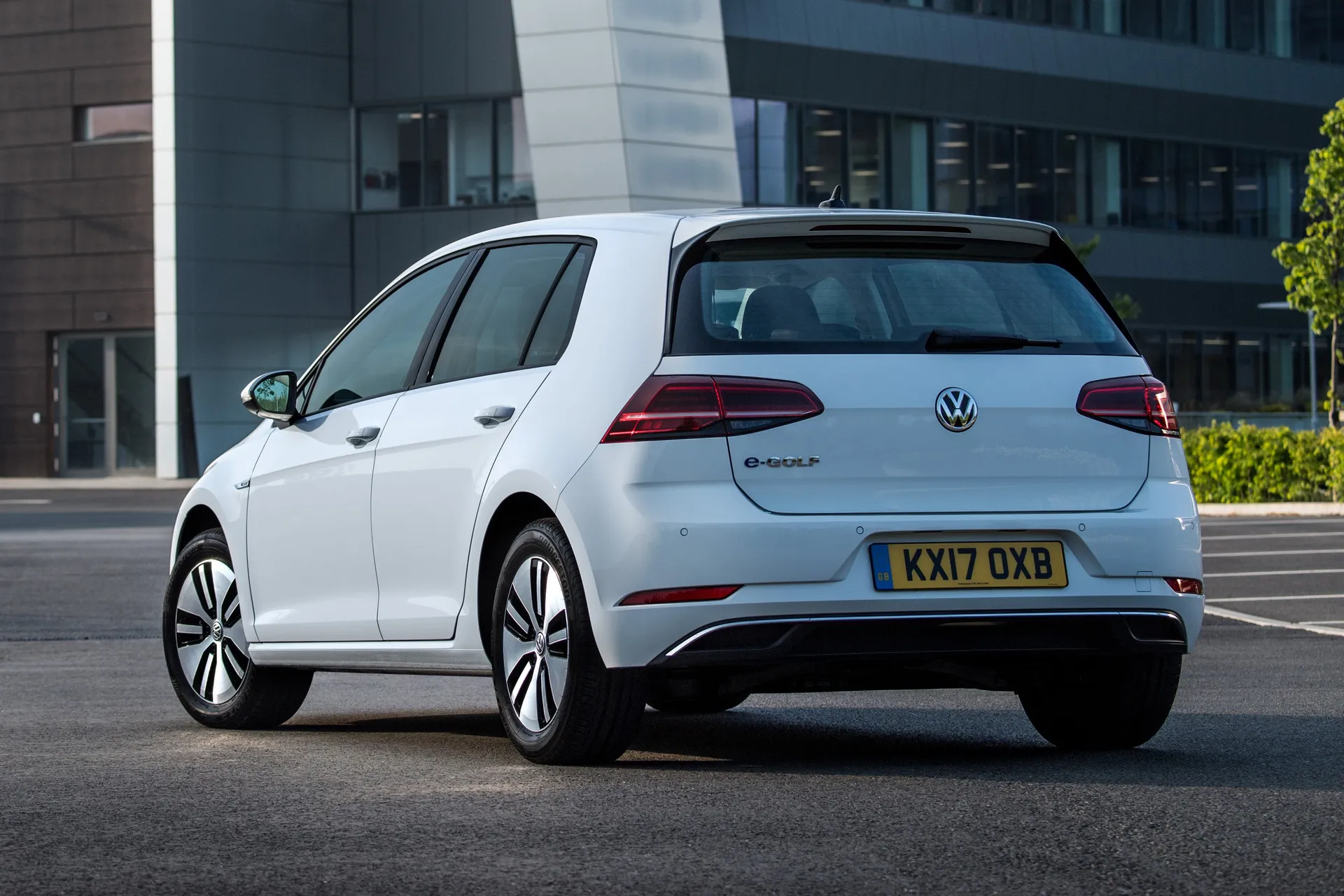
If you get 100 miles from that charge, that works out at around 5p per mile, which is pretty good. Even the most efficient diesel Golfs will cost you at least twice as much in fuel.
How reliable is a Volkswagen e-Golf?
Electric cars are generally very reliable. There's no engine to go wrong, while the electric motor and battery pack in the Volkswagen e-Golf are proving to be dependable. We've heard of very few common issues reported with the Volkswagen e-Golf, while the brand ranked in the top 10 in the latest HonestJohn.co.uk Satisfaction Index.
Insurance groups and costs
Some electric car owners do find that they’re slightly more expensive to insure than a conventional petrol or diesel car. If you’re worried, it’s worth shopping around for quotes - and consider companies which specialise in insurance for electric vehicles.
This is reflected in the e-Golf’s placement in insurance group 26. That’s quite high compared to equivalent combustion-engined Golfs, and even higher than the Nissan Leaf (which is in insurance group 21).
VED car tax: What is the annual road tax on a Volkswagen e-Golf?
A perk of electric cars with zero tailpipe emissions is they are exempt from car tax. The rules have changed a bit over the years but, essentially, you won’t have to pay a yearly fee to the Government to tax your Golf. Electric cars are also ULEZ compliant, congestion charge exempt and, if you live within certain London boroughs, you might even get a discount on your parking permit...
How much should you be paying for a used Volkswagen e-Golf?
"The Volkswagen e-Golf has been on sale since 2014, which means there are plenty on the market. It didn’t sell in the same numbers as a Nissan Leaf, however, so used prices are generally quite strong and you might have to travel further to find one that meets your requirements."
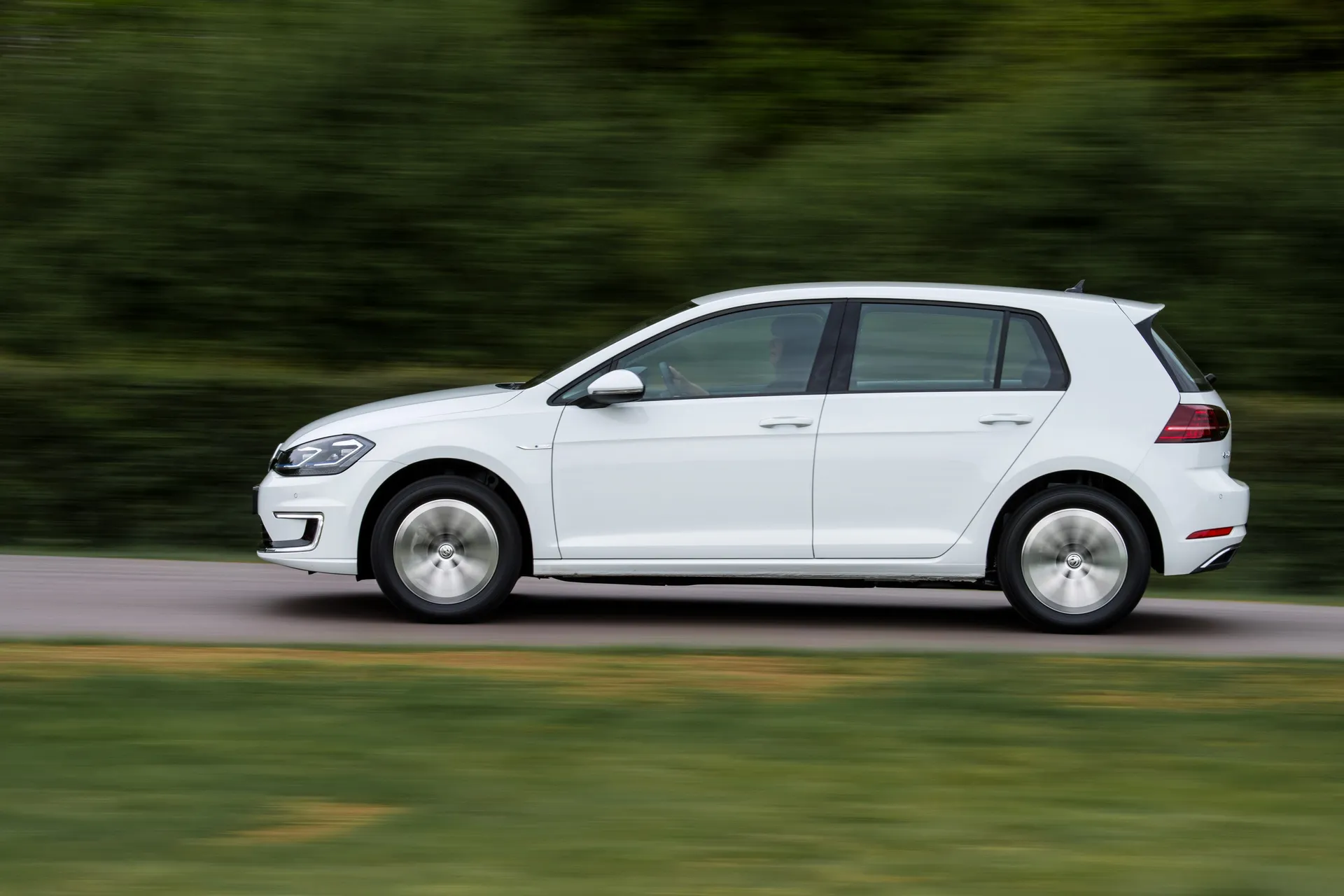
A tidy five-year-old example will set you back around £16,000. Most have been used for short urban journeys, so you’re unlikely to find one with high miles (certainly compared to a diesel Volkswagen Golf, for example).
There are more three-year-old examples hitting the market as they come out of lease and finance deals. Expect to pay in the region of £20,000 for one of these - depending on condition and whether it’s fitted with any desirable options.
While Volkswagen has now ended production of the e-Golf, you might be able to find an as-new pre-registered example. These are generally ex-demonstrators or cars that have been registered by the dealer in order to meet targets. We’ve seen these selling for between £27,000 and £30,000 depending on specification.
Trim levels and standard equipment
The Volkswagen e-Golf is, in effect, a trim level in itself. That means you don’t get much choice but, equally, all used e-Golfs will be pretty much the same in terms of standard equipment.
The interior gets an eight-inch navigation system with Apple CarPlay and Android Auto, as a unique e-Golf instrument cluster. There are cloth seats (with height and lumbar adjustment) and a leather steering wheel with an e-Golf logo.
On the outside, 16-inch alloy wheels with low rolling resistance tyres are fitted as standard, as well as what Volkswagen describes as the ‘e-Golf styling pack’. This includes bespoke front and rear bumpers, a rear roof spoiler and side sills. Other exterior features unique to e-Golf include a blue stripe on the radiator grille, bespoke C-shaped LED daytime running lights and tinted LED rear lights. Did you know that the e-Golf was the first Volkswagen model to feature LED headlights? You do now.
Driver assistance tech includes adaptive cruise control and a number of drive modes to choose from (Eco, Normal, Sport and Individual). There’s a dusk sensor, with automatic headlights, and there’s a clever driver personalisation profile - allowing you to set up four individual profiles and assigned to a key. This presets things like the radio station and phone connectivity.
Charging accessories include two charging cables - one a 32amp AC able for a home wallbox, as well as a 10amp main charge cable (this is the one with a three-pin plug that’ll plug into your domestic sockets at home).
Desirable options to look out for include the heat pump which recycles heat from the ambient air and drivetrain components, reducing the energy needed to warm the car up via the car’s heating system. This provides a useful extra few miles of range, especially when it’s cold in winter.
We also like the Winter Pack, which was a £400 option when new and added headlight washers, heated front seats, heated windscreen washer jets and a low washer fluid warning light.
Ask the heycar experts: common questions
Has the Volkswagen e-Golf been discontinued?
Is the Volkswagen e-Golf fully electric?
How much is a Volkswagen e-Golf?
Get our latest advice, news and offers
Keep me updated by email with the latest advice, news and offers from heycar.
By submitting you agree to our privacy policy
